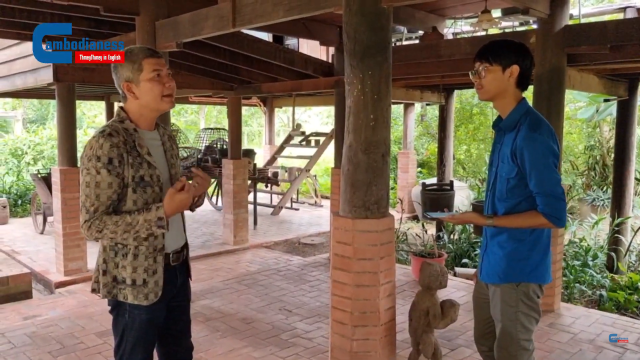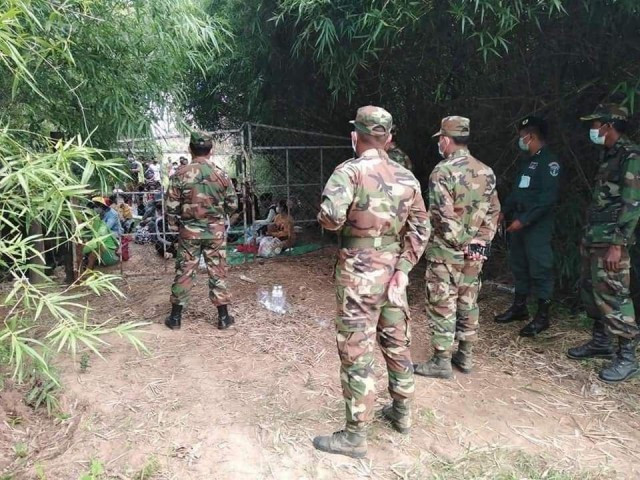The New Life of a Century-Old Khmer Wooden House in Siem Reap

- By Ky Chamna
- July 22, 2023 1:00 PM
SIEM REAP — About 140 years old and having been the witness of the rise and fall of multiple regimes in Cambodia, this Khmer wooden house from Kralanh district in Siem Reap province stands as a superb example of the traditional architecture in the region.
Studied and preserved by the renowned vernacular architect Hok Sokol, it was brought to its current location more than a decade ago and is enjoying a new lease on life after extensive renovation. To help keep the knowledge alive for the future generations in the country, he co-authored the book “Cambodian Wooden Houses: 1,500 Years of Khmer Heritage” with Darryl Collins, an Australian art historian and museum expert who worked at the National Museum in Phnom Penh for several years and passed away two months ago.
Ky Chamna: Published with photographs and detailed descriptions as well as plans of wooden houses, why did you feel it was important for this book to be compiled and published?
Hok Sokol: Because there is a real need. Throughout history, we have had many stone temples built that remain standing today, and material from many sources have been written about them. However, how people have lived in their wooden houses has not been widely studied or recorded. Living architecture is important as well. Seeing the stature of a sacred structure such as the Angkor Wat temple, it can be understood that the livelihood and the standard of living of the people during that time might have been of high standard as well. There are not many documents about Khmer wooden houses. So, I had the chance to research. We spent more than 15 years putting this book together. There will be a Khmer and a French version of it by the end of the year. Apart from this book, I also write shorter articles on the Khmer Renaissance page [of the Yosothor website, a Cambodian cultural research organization].

Ky Chamna: As an architect specialising in Khmer wooden houses, do you focus only on the physicality of the structure or also on the anthropological side that goes along with it?
Hok Sokol: When you study the culture of houses, of course you need to know the anthropological side of it. Otherwise, you will find nothing in your research. When you search, if you want to find a good wooden house, you have to know where to find traditional villages that have existed at least 100 years. I did a lot of research in provincial areas. Communication back then was not done through the internet like today, but by word of mouth. When you go to villages, you may ask the locals where one can find a good traditional wooden house. Then, they recommend it and we go to see it. This particular house was found by accident in 2008 and it was finally moved here, piece by piece, in 2010. Although the house was outside the geographic area I was studying, it was recommended by villagers, and so I went to see it. The previous owner of the house had had to move away for work and the house had been left to termites and vegetation. We contacted the owner to ask to purchase it. Darryl Collins, with whom I wrote this book, also liked the house, and so we did it. We brought it here.

Ky Chamna: When you first saw the house at its original location, how damaged was it? Was it tilted to one side or unstable?
Hok Sokol: No, it was not tilted or unstable. However, the clay roof tiles were broken, there was leakage, and some parts of the house were occupied by termites. More or less, the shape looks the same. I replaced some columns, cut away parts of old ones and replaced the void with concrete footings. I cannot determine the exact age of this house since there is no record on it. However, I can guess that it could have been built toward the late 19th century or approximately 140 years ago.
_1690002575.jpg)
Ky Chamna: In Cambodia, moving wooden houses around is not something that is too rare to see. Sometimes, an entire house is lifted all at once by an army of helpful villagers. In the case of this house, how long and how many people did it take to lift it and put it in place?
Hok Sokol: It took one week and seven people to dismantle the structure. Two master carpenters and five workers could do the job. Traditional wooden houses are not hard to move. The principle is that houses like these are built by joining columns and beams with a combination of wedge locks or pins. We just move the wedge locks or pins, and the house can be taken out one piece at a time. However, it took us around 10 months to properly put it back together.
_1690002593.jpg)
Ky Chamna: During the reassembly, did you retain the traditional techniques?
Hok Sokol: Yes, I still retained the traditional techniques. To support the floors, we have a foot barrier for the beam so that the structure can be flexible. You see, this barrier here is high and the other one is shorter. But it does not matter as long as the floor is levelled.
_1690002614.jpg)
Ky Chamna: However, why couldn't the floor be straight in the first place?
Hok Sokol: Working with wood is not like working with concrete. Naturally, they tend to bend or form irregularities. So, the use of foot barriers helps adjust the levelling of the floor.
_1690002650.jpg)
Ky Chamna: Since this wooden house had made its way from far away and saw renovation throughout the years, why would there be a smaller brick house extending this older house nearby?
Hok Sokol: Even though we try to preserve the traditional houses, we also need to be able to think about the updated way of living. We do preserve, but this house is not completely liveable or comfortable indoor. To make it more liveable, we have to add walls, air-conditioners or more bedrooms. However, if we do it, we will lose the original structure. That is why it is also important to have an extension.

Ky Chamna: How long would you think this house will last?
Hok Sokol: With good maintenance, I think it can last another 50 years or even more.
Ky Chamna: Another 50 years or more before requiring a major renovation?
Hok Sokol: Well, we will not need big renovation work except for unforeseen natural disasters. With normal situations, normal maintenance would be enough for the house to last even another century.
_1690002696.jpg)
Watch this interview on video on YouTube and Facebook
Watch an interview on “Why Khmer vernacular wooden houses are in need of preservation?” on YouTube and Facebook















